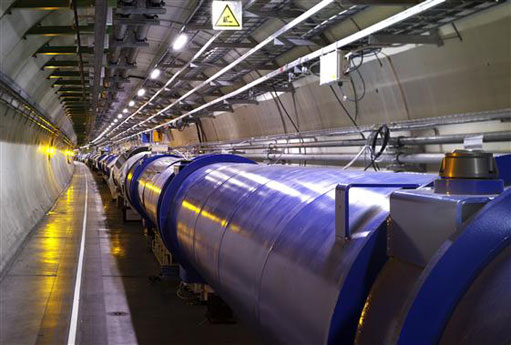
ATLAS e-News
23 February 2011
Update on the LHC
6 October 2008

The tunnel, sector 1-8 (archive)
The news that the Large Hadron Collider is down until the spring has been a major blow to morale all around CERN. We know that when it comes to a machine of the size and complexity of the LHC, hiccups like this are a normal part of the start-up process. But when first collisions seemed so close, the delay until next year is disappointing.
Nevertheless, the team working on the accelerator isn’t wasting time hanging their heads. Preliminary investigations revealed that a problem in an electrical connection between two magnets caused a helium leak. Between one and two tonnes of liquid helium, of the 15 tonnes in the sector, spilled into the tunnel according to Lyn Evans, Project Leader of the LHC, when he spoke at the LHCC meeting on September 24th.
The investigative team believes that a faulty connection between two superconducting cables, called a bus bar splice, is to blame. These connections must be able to pass 12,000 amperes of current.
“The suspicion is that one of these splices was indeed resistive,” said Jos Engelen, Chief Scientific Officer of CERN, on Wednesday of last week. “Even a very very small resistance is enough to warm it up locally to the point that it will melt.”
Dr Engelen is quick to point out that nothing can be known for certain until the magnets have been warmed to room temperature and opened for full inspection. While it hasn’t yet been confirmed, accelerator scientists have identified a likely scenario for the cause of the helium leak. The spliced region warmed so quickly that the superfluid helium system could not keep up with the cooling demand, causing the bus bar to melt or create an electric arc – either of which could have created a hole in the helium tube.
Progress toward a full inspection is moving quickly. Some regions of sector 3-4 are already approaching room temperature, and electricity has been restored to the tunnel. The details of the electrical cut aren’t known, but it may have been the emergency stop system.
The next step is an inventory of damaged elements that need repairs or replacements. Dr Evans listed dipole and quadrupole magnets among the damaged parts. Once the full inventory is made, the team can decide which repairs can be made on-site and which require the parts to be removed for repair or replacement.
“The incident is very localised,” said Dr Engelen, so the number of damaged magnets is small. Dr Evans assured physicists that there will be no shortage of replacements, if they prove necessary.
When the repair plan is decided, the Accelerator and Beam group will schedule winter maintenance a bit sooner than anticipated. On Friday, Director General Robert Aymar announced that the start-up
could begin a month earlier than anticipated, bringing it hopefully to April.
The decision of whether to run 10 or 14 TeV collisions is yet to be made, but Dr Engelen would be perfectly content to see 10 TeV collisions in the LHC’s first year of operation.
US LHC blogger Ken Bloom put this bump in the road into some perspective, especially for those who remember the start of Run II at Fermilab’s Tevatron. While start-up was difficult for that accelerator as well, he reminds, “Let’s remember that in fact things did turn around; CDF and D0 got rolling.”
He adds: “Once the LHC really gets rolling, the new physics might start hitting us in the face, and we’re going to be prepared.” In the coming weeks, expect an update on what ATLAS is doing with the extra preparation time.

Katie McAlpineATLAS e-News |